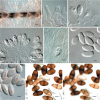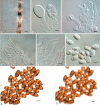Phylogeny and morphology of four new species of Lasiodiplodia from Iran
- PMID: 21339962
- PMCID: PMC3028508
- DOI: 10.3767/003158510X524150
Phylogeny and morphology of four new species of Lasiodiplodia from Iran
Abstract
Four new species of Lasiodiplodia; L. citricola, L. gilanensis, L. hormozganensis and L. iraniensis from various tree species in Iran are described and illustrated. The ITS and partial translation elongation factor-1α sequence data were analysed to investigate their phylogenetic relationships with other closely related species and genera. The four new species formed well-supported clades within Lasiodiplodia and were morphologically distinct from all other known species.
Keywords: Botryosphaeriaceae; EF-1α; ITS; Lasiodiplodia; phylogeny; taxonomy.
Figures





References
-
- Abbas SQ, Sutton BC, Ghaffar A, Abbas A.2004. Reassessment of Sphaeropsis undulata Berk & Curt. Pakistan Journal of Botany 36: 209 – 218
-
- Alves A, Correia A, Luque J, Phillips AJL.2004. Botryosphaeria corticola sp. nov. on Quercus species, with notes and description of Botryosphaeria stevensii and its anamorph, Diplodia mutila. Mycologia 96, 3: 598 – 613 - PubMed
-
- Alves A, Crous PW, Correia A, Phillips AJL.2008. Morphological and molecular data reveal cryptic species in Lasiodiplodia theobromae. Fungal Diversity 28: 1 – 13
-
- Arx JA von .1987. Plant-pathogenic fungi. Cramer, Berlin:
LinkOut - more resources
Full Text Sources
Other Literature Sources
